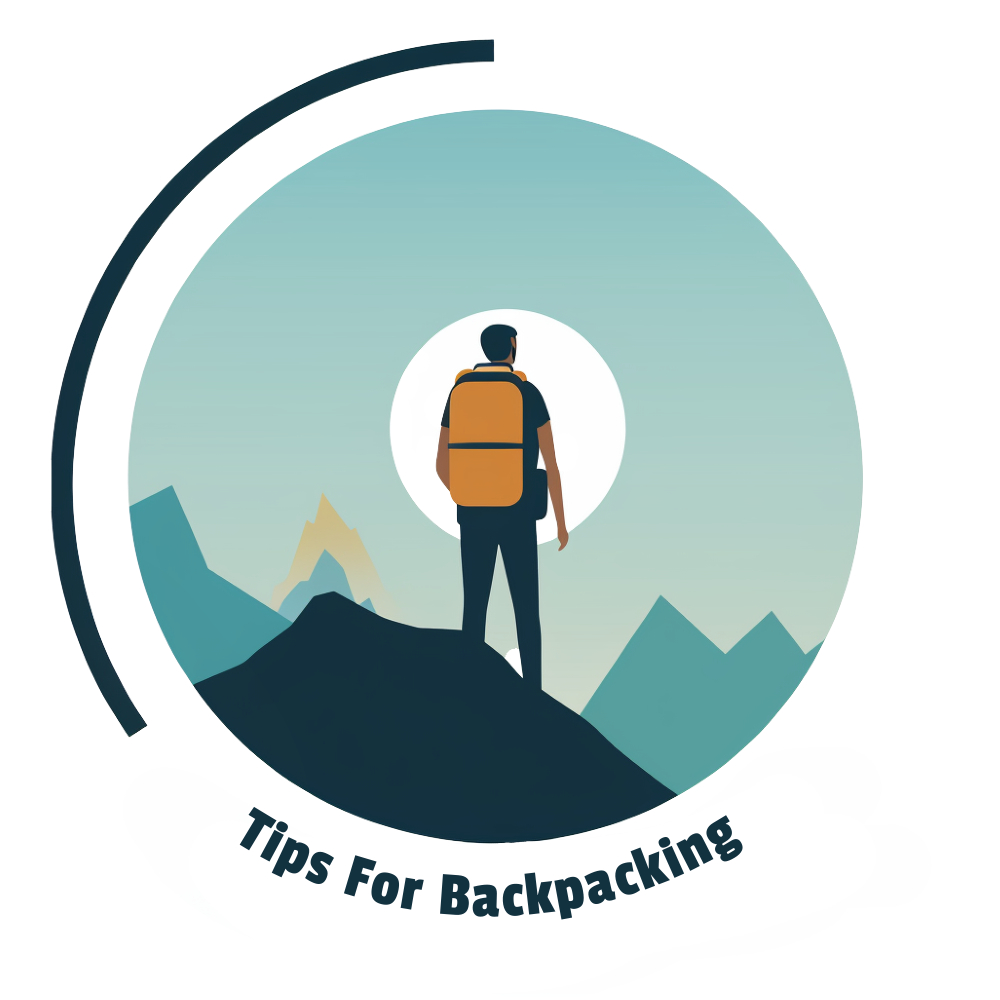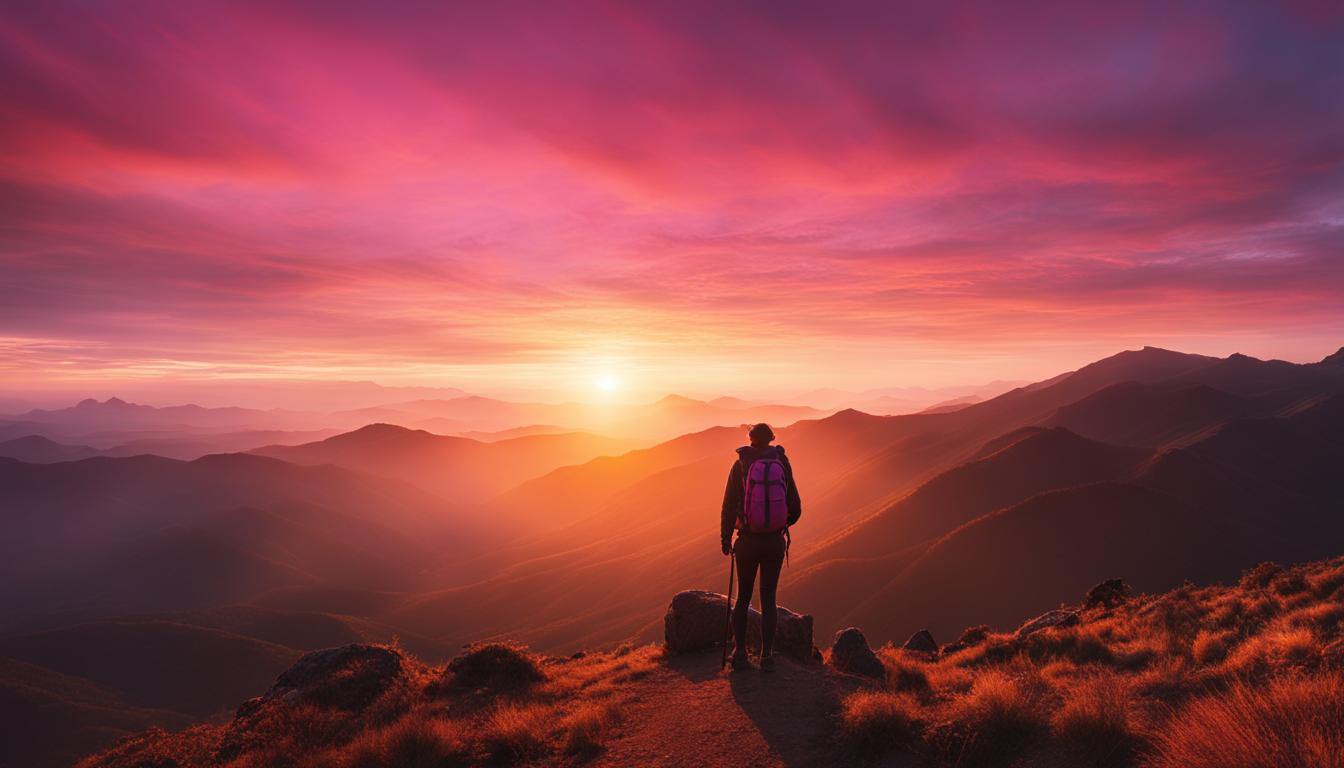As someone who once stood where you are—curious and eager, yet slightly overwhelmed by the concept of carrying my life on my back through the wilderness—I understand the mix of emotions you’re grappling with on how to start backpacking with no experience. Today, I’m here to share a wealth of essential knowledge for new backpackers that will equip you for your foray into the wild, wandering world of backpacking. This beginner backpacking tips article isn’t just an introduction to backpacking guide; it’s a beacon to illuminate your journey from a mere day hiker to a seasoned backcountry traveler.
I’ve compiled an in-depth beginner guide to starting backpacking trips, which encapsulates all the lessons, insights, and advice that I wish had been handed down to me when I first shouldered a pack and set off into the unknown. Rest assured, you’re about to embark on one of the most rewarding adventures of your lifetime—one where the clatter of civilization fades, and the rhythms of nature take center stage.
Backpacking for Beginners – Key Takeaways
- Backpacking transcends day hiking, offering a unique immersion into nature.
- Essential backpacking gear is the cornerstone of any successful trip.
- Preparation and practice with your gear are critical before hitting the trail.
- A proper pack weight relative to your body weight ensures comfort during the journey.
- Learning navigation skills and wilderness ethics contributes to a safe and enjoyable experience.
- Finding the right footwear can make or break your backpacking adventure.
- With the right mindset and preparation, backpacking becomes an enriching, life-affirming activity.
Understanding the Backpacking Basics: A Primer for New Adventures
If you’re intrigued by the prospect of backpacking, whether drawn by the allure of remote landscapes or the freedom of wandering untethered from the grind of daily life, consider this your official introduction to the enchanting world of backpacking. At its core, backpacking combines the simplicity of hiking with the complexity of self-sustained living in the outdoors.
An Overview of What Backpacking Really Entails
When I speak of backpacking basics, I’m referring to the art of journeying through nature’s vast canvas with all of your essentials neatly packed on your back. Spanning multiple days, or even weeks, backpacking calls upon adventurers to carry their shelter, food, water, and all necessities as they navigate through breathtaking and often challenging terrains. This comprehensive beginner’s guide to backpacking is designed to gently usher you into the experience, ensuring you’re well-prepared for the practical reality that awaits outside the comfort zone of day hikes.
Comparing Day Hiking and Backpacking: Distinct Differences
| Activity | Duration | Gear | Preparation | Skill Set |
|---|---|---|---|---|
| Day Hiking | Single Day | Minimal; basic essentials | Moderate; less logistics | Basic outdoor proficiencies |
| Backpacking | Multiple Days | Extensive; all overnight gear | Intensive; thorough planning needed | Advanced; greater self-sufficiency |
In comparing day hiking and backpacking, it’s evident that although the inherent joys of trekking are central to both, backpacking takes it up a notch. While day hiking allows you to dip your toes into the wilderness and return to the comforts of home, backpacking calls for a deeper commitment — both in time and gear. You’ll discover differences between hiking and backpacking, as the latter requires you to streamline your life into a pack, thus adding layers of planning, strategy, and, of course, the joy of self-reliance.
The Joy of Backpacking: Why Embark on This Journey
To those asking themselves, “Why go backpacking?“, I can affirm that the reasons are manifold. There is an undeniable charm in watching a sunset or greeting a sunrise from a vista unreachable by the day hiker. To become part of the landscape’s diurnal shift, where the stars seem touchable and nocturnal wildlife makes its presence known, is to experience the quintessence of the immersive backpacking experience.
Those transformative moments don’t simply pass—they linger, shaping memories and, quite often, reshaping lives. For me, backpacking is not just a hobby; it’s a pursuit that has cultivated resilience and clarity in my life. This beginner’s tutorial to the essentials of backpacking aims to plant similar seeds of discovery for you as you seek adventures that go beyond beaten paths.
- Vast wilderness exploration
- Connection with nature’s chronology (sunrises, sunsets, starry nights)
- Mental and physical challenges leading to personal growth
- The satisfaction of self-sufficiency in the wild
“Backpacking is the pursuit of a simpler life, where the dawn’s first light and the twilight’s last star become familiar friends on a journey of discoverable moments in the wild.”
Choosing Your Backpacking Gear: The Foundation of Your Adventure
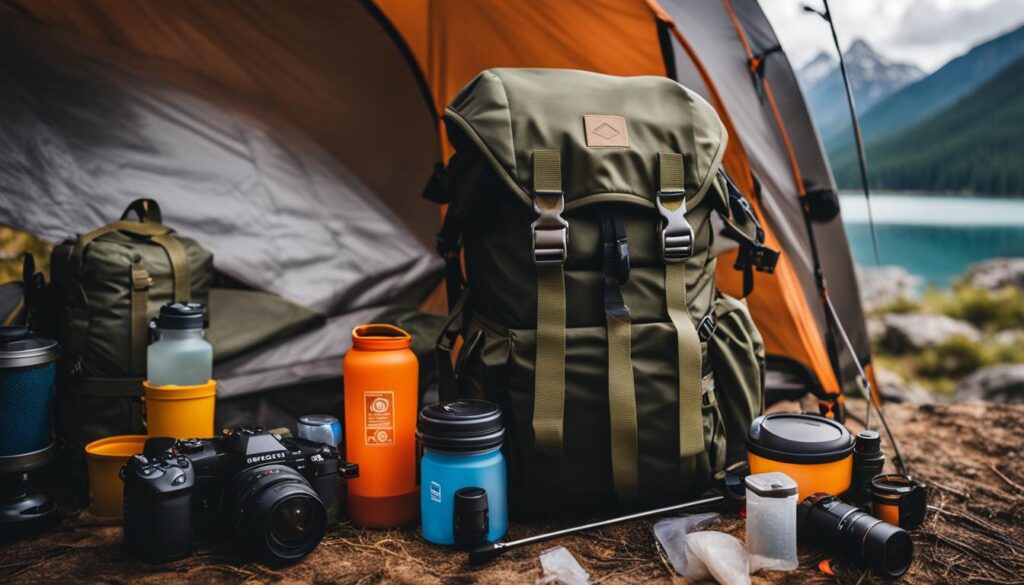
Stepping into the world of backpacking can be a transformative experience, but it all begins with the right gear. Selecting essential gear for your first backpacking journey isn’t just about comfort—it can be a matter of safety in the unpredictable wilderness. As you contemplate your inaugural expedition, it’s crucial to focus on backpacking gear for beginners that’s reliable, functional, and tailored to your needs.
Imagine the diverse landscapes that await you—from the azure lakes nestled in alpine meadows to the stoic grandeur of towering peaks. Your gear is your lifeline in these settings, and I cannot overstate the importance of investing in quality backpacking equipment. Whether you’ve been lured by the mystique of off-grid trails or seek the serenity that only a night under the stars can offer, here’s the gear that should be on your checklist:
- A capable backpack with a 40 to 75-litre capacity
- A sturdy, lightweight tent weighing less than 4 pounds
- A three-season sleeping bag for year-round comfort
- An insulated sleeping pad to fend off the cold ground (minimum R-value of 2.5)
- Comprehensive cooking gear including a dependable backpacking stove
As a beacon for aspiring backpackers, allow me to illuminate the path of preparation. Consider renting or borrowing gear to get a feel for what suits your personal preferences—it’s a pragmatic approach that can ease financial restraints without compromising on a safe and enjoyable experience. Before you venture out into the wild, acquaint yourself with every strap, zipper, and buckle of your equipment. Familiarity breeds efficiency and confidence in your outdoor habitat.
“The wilderness beckons to the prepared, and your backpack is your unwavering partner on the journey of discovery.”
| Gear Category | Essential Features | Notes for Beginners |
|---|---|---|
| Backpack | 40-75L, comfortable fit, adjustable straps | Begin with shorter trips to decide on your preferred pack size |
| Tent | Under 4 lbs, waterproof fly, easy setup | Practice pitching your tent to reduce setup time in the field |
| Sleeping Bag | Season-appropriate, lightweight, hooded for warmth | Opt for quality insulation to ensure restful sleep |
| Sleeping Pad | Insulated, R-value at least 2.5, compact design | Don’t underestimate the warmth and comfort a good pad provides |
| Cooking Gear | Efficient stove, lightweight cookware, fuel-efficient | Cooking is part of the experience; choose gear that’s easy to use |
Your gear is the cornerstone of your wilderness experience—a good selection can be the difference between a grueling ordeal and a triumphant memory etched into the fabric of your outdoor life. Walk with me as I continue to delve deeper into the intricate tapestry of backpacking. Next, we explore the intricate dance of packing your gear, where every ounce tells a story and every item plays a crucial role in the unfolding adventure that is backpacking.
Prepping Your Backpack: Packing Strategies for Efficiency and Comfort

Embarking on a backpacking adventure is akin to moving into a new home — albeit temporarily and in the great outdoors. The process of prepping your backpack mirrors setting up your living space, with the challenge lying in making it as efficient and comfortable as possible. Think of it as a mobile sanctuary where everything has its place and purpose.
In the realm of packing strategies for backpacking, the golden rule is balance — both physical and in terms of what’s essential against what’s a luxury. Let’s delve into the art of packing, where the seasoned backpacker’s mantra is to pack light but pack right.
Essential Packing Tips for a Balanced Backpack
Finding the sweet spot in your pack’s weight is paramount to enjoying the trails without a hitch. Heeding essential packing advice for new backpackers, we find that an overloaded backpack can be as burdensome to your journey as forgetting a critical item. Aim for your pack’s total weight to not exceed 15-20% of your body weight for the utmost comfort and maneuverability.
Here’s an essential rundown:
- Sturdy Pack: A cornerstone to any backpacking trip.
- Shelter: Your home away from home must be reliable and straightforward to set up.
- Water Treatment Supplies: You can never be too safe with your water source.
- Cooking Equipment: Meals are morale boosters, ensure you’ve got the gear to make them enjoyable.
To ensure everything is in working order and familiar, it’s wise to spend some time prepping your backpack at home. This preparation is where you’ll get to know the nuance of your gear — practicing the pack and unpack, ensuring nothing is left to chance.
“To pack light is to free oneself for the journey ahead, yet to pack smart is to anchor oneself in readiness for what the trail may bring.”
Deciding What to Bring: The Delicate Balance of Necessities and Luxuries
Now, the conundrum of deciding what to pack for backpacking. It’s an intricate dance between the necessities and luxuries, the must-haves and the nice-to-haves. Your pack, after all, should contain all you need to survive and a few items to help you thrive.
Consider itemizing your gear into categories, and then review each one with a critical eye:
- Clothing & Weather Gear
- Food & Nutrition
- Navigation & Tools
- Sleep System
- Hydration
- Emergency & First Aid
Aim to equip yourself for the worst but pack for the best. Clothes should be versatile and layerable, food should be high-energy and easy to prepare, and navigation tools should be both reliable and intuitive to use. As for water, always plan for more than you think you’ll need, and always filter or purify it, no exceptions.
Necessities and luxuries for backpacking trips could include a book or a lightweight camera, but always weigh the benefits against the payload. After all, the stories from your adventures will be the lightest treasures you carry back.
| Category | Item | Weight (approx.) | Necessity or Luxury |
|---|---|---|---|
| Sleep System | Understanding the Backpacking Basics: A Primer for New Adventures | 2-4 lbs | Necessity |
| Hydration | Water filter/purifier | 0.5-1 lb | Necessity |
| Navigation Tools | Map and compass | 0.2-0.3 lb | Necessity |
| Food & Nutrition | Stove and fuel | 1-3 lbs | Necessity |
| Luxury Items | Camera or eBook reader | 0.5-1.5 lbs | Luxury |
In the harmony of items to pack for a backpacking adventure, one learns that there’s a rhythm to packing that aligns with one’s personal trekking tune. With every trip, your packing list will evolve as you decipher what truly counts on the trail. Go, explore, adapt, and refine your backpacking symphony.
Finding the Right Footwear: A Step Towards Comfortable Backpacking
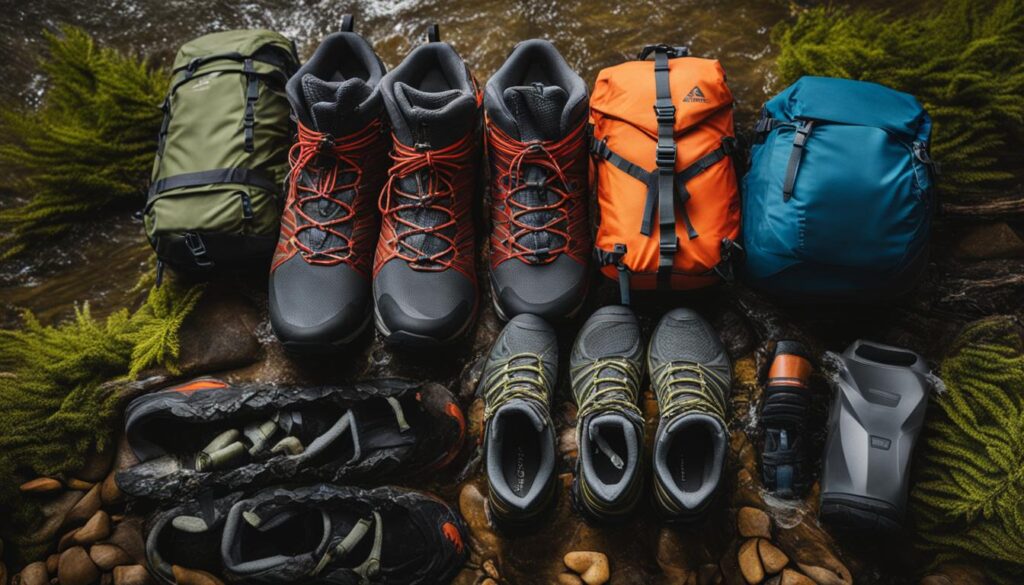
Experienced backpackers know that choosing backpacking footwear isn’t a mere afterthought—it’s a crucial step towards ensuring every hike is a good one. When I remember my first few excursions, I recall how the importance of comfortable backpacking boots quickly became clear. Your shoes are your foundation; they dictate your pace, comfort, and even your stability on uneven terrains.
There are a few footwear considerations for backpackers that need to be addressed before setting any foot on the trail. Your boots will carry you across streams, up mountains, and through the quiet woods, so they must be well-chosen companions. The following tips are what I’ve gleaned when selecting the ideal pair:
- Traction and Durability: Look for soles with deep lugs and high-quality rubber for grip and longevity.
- Ankle Support: High-cut boots with adequate ankle support help prevent sprains, especially under the weight of a full pack.
- Material: Waterproof yet breathable materials are key for comfort in varying weather conditions.
- Toe Room: Ensure there’s a thumb’s width between your longest toe and the boot end to accommodate for foot swelling and downhill motion.
Furthermore, the best advice I can offer is to break in your boots thoroughly before you hit the trail. Developing hotspots or blisters miles from the nearest road is a lesson many learn the hard way. Take your boots on multiple short hikes, gradually increasing the weight in your pack. This will mold the boots to your feet and highlight any pressure points or slip areas.
“In every walk with nature, one receives far more than he seeks.” – John Muir
| Boot Feature | Why It’s Important | Recommendation |
|---|---|---|
| Fit | Prevents blisters and gives support | Ensure a snug, but not tight fit with your hiking socks on |
| Weight | Heavier boots can lead to quicker fatigue | Select the lightest boots that still offer needed protection and support |
| Water Resistance | Keeps feet dry in wet conditions | Look for waterproof membranes like GORE-TEX |
| Breathability | Minimizes sweat and overheating | Choose materials that wick away moisture |
| Outsole Grip | Essential for traction on mixed terrains | Opt for deep lug patterns and reliable rubber compounds |
My journey has taught me that the right pair of boots is your staunchest ally on the trail. I implore you to consider these tips when choosing backpacking footwear, as it is indeed a major step towards escaping into the wilderness with confidence and comfort. May your steps be light, your tread sure, and your adventure moments plentiful.
Navigating the Wilderness: Essential Skills for the Trail
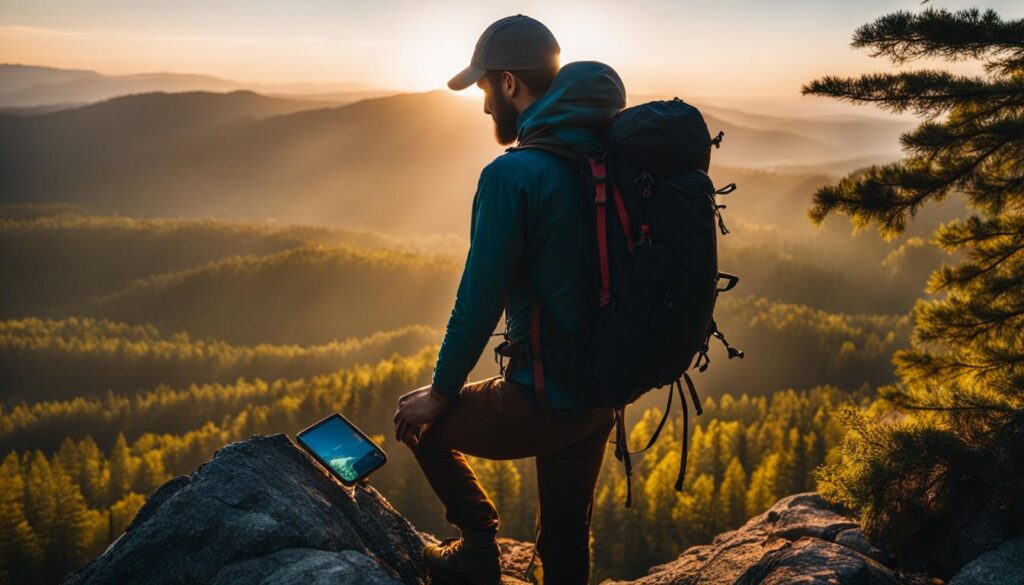
As I reflect on countless journeys, I can’t underscore enough the vital role of wilderness navigation skills in backpacking. Whether it’s a dense forest or a sprawling mountain range, knowing how to find your way is just as critical as the gear in your pack. Let me share with you the essentials of navigation—knowledge that could very well save your life when you’re miles away from civilization.
Map Reading and Compass Basics
First things first, map reading for backpackers is an invaluable skill. When you understand topographic lines and can interpret the symbols adorning your map, trepidation turns into confidence. A map tells stories of the land—you’ll see where water flows, paths merge, and elevation changes. Now, introduce a compass to this narrative. With compass basics under your belt, you align the map’s language with the land’s features, forging a connection that guides you through the wilderness.
I always practice these skills before heading into less familiar terrain. Starting with short, local hikes, I use my map and compass to navigate, reinforcing the techniques until they become second nature. And trust me, knowing that I can rely on these skills provides an assurance that no battery-powered device ever could.
Modern Tech vs Traditional Navigation: A Balanced Approach
In today’s age, we’re blessed with modern technology for navigation—GPS units, satellite messengers, and smartphone apps. These tools, like the inherent debate of GPS vs traditional navigation tools, offer an additional layer of safety with their pinpoint accuracy and real-time data. But they are no substitute for knowing the basics.
That’s why I advocate for balancing navigation methods. As much as I appreciate the convenience of my GPS, I never solely depend on it. Batteries die, signals get lost, and devices fail, often when you least expect it. Combining the reliability of traditional tools with modern tech’s ease creates a harmonious navigation strategy, keeping you safe and on track, no matter what Mother Nature throws your way.
| Navigation Tool | Pros | Cons | Best Use |
|---|---|---|---|
| Topographic Map | Detailed terrain features, no power needed | Requires skill to interpret | Core navigation and pre-trip planning |
| Compass | Reliable, durable, functions without satellites | Needs a map for effective navigation | Direction finding and cross-country travel |
| GPS Device | Accurate positioning, electronic mapping | Dependent on battery and satellite signal | Real-time tracking and wayfinding |
| Smartphone Apps | User-friendly interface, additional features | Battery life can be limiting, not rugged | Supplementary navigation and trip logs |
“A map and compass will never run out of battery life, but embracing modern tools broadens your horizons, just ensure it’s not at the expense of your safety and preparedness.”
Remember, the art of navigation is about using all available resources to ensure a successful hike. As I’ve ventured through varying landscapes, the harmony between old-school orienteering and modern navigation aids has often been the melody to the song of my wanderlust, ensuring that I find my way and make it back to share the tales.
Campsite Setup 101: Selecting and Prepping Your Overnight Home
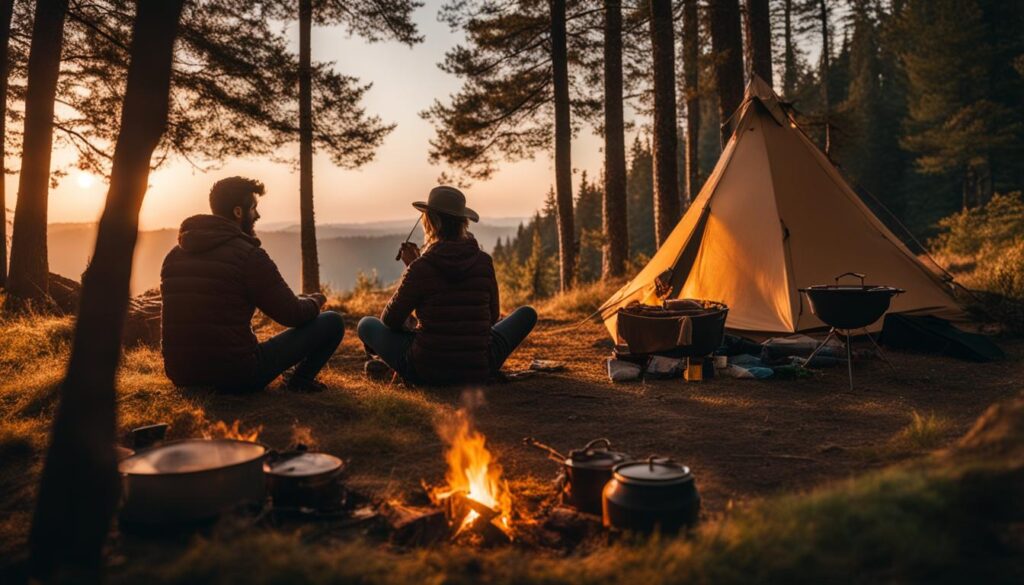
For many first-time backpackers, the prospect of setting up a makeshift home in the great outdoors is thrilling yet inherently wrought with unknowns. The crux of a memorable backpacking expedition often lies not in the miles trekked but in the serenity and security of your nightly encampment. Mastering the campsite setup for beginners isn’t just a skill – it’s an intimate dance with nature that begins with identifying the perfect spot and ends with leaving no trace.
Let’s start with the basics of backpacking campsite selection. As I smear dirt on my face and heave my pack off for the day, the first thing I scout for is flat ground. I look for a site that promises a comfortable sleep without the perilous slide downhill amidst dreams. A place that’s naturally shielded from howling winds and an unforeseen storm surge. But equally important is the proximity to water – close enough for convenience but sufficiently distant to preserve the sanctity and safety of both our precious resources and my temporary abode.
Preparing your overnight camping spot also includes an assessment of potential hazards – trees prone to lightning strikes or falling branches, areas with insect infestations, or too much exposure to the elements. An ideal spot is one that maximizes safety and comfort while harmonizing with the surrounding ecosystem.
Good campsite selection is the bedrock of Leave No Trace principles—it’s about harmonizing with the environment, not imposing on it.
So, after finding that sweet spot where the earth seems to welcome my weary soul, I roll out my abode for the night: my trusty tent. The ease of my night hinges on a tent that has been pitched, adjusted, and mastered long before the wilderness calls. Yes, practice is key – the more familiar I am with constructing my shelter, the less likely I’ll be cursing the sunset with tent poles flailing.
But the tent is just one part of my campsite orchestra. What about the rest? Well, that’s a symphony that evolves with experience, but here’s a starter list of tasks that I follow diligently:
- Clear the ground of debris and rocks to welcome a tent and a good night’s sleep.
- Consider the wind, and position the tent’s entrance away from prevailing gusts.
- Instead of a bonfire, a camp stove lights my culinary masterpieces while preserving the land.
- Food and scented items are bear-bagged or stowed in a bear canister, hoisted high, away from my sleeping quarters.
- Last light ritual: making mental notes of the camp layout to navigate in the night if nature calls.
And when the night has gifted rest and dreams of trails yet traversed, the morning brings responsibility. Breaking camp with reverence, ensuring that my temporary home leaves no scars, no litter – not a whisper of my presence. That’s the ethos.
| Duty | Action Steps | Leave No Trace Emphasis |
|---|---|---|
| Tent Site Selection | Flat ground, away from hazards, close to water sources | Minimize campsite alterations and avoid damaging surfaces |
| Environmental Considerations | Check for animal activity, overhanging dangers, flooding potential | Respect wildlife and avoid disrupting habitats |
| Tent Setup Practice | Repeatedly pitch tent at home for efficiency in the field | Campfire-free, utilize camp stoves to avert accidental fires |
| Food Storage | Use bear canisters or bear bags hung out of reach | Keep wildlife wild; never feed animals and protect your food |
| Camp Breakdown | Leave the site cleaner than you found it, pack out all trash | Pack it in, pack it out—leave what you find for others to enjoy |
As a fledgling backpacker, the campsite is where I learn to walk in nature’s rhythms, and it’s where I rest before another day’s journey. I humbly offer this mantra: safety, practice, and Leave No Trace – the trinity that guides my choices, sustaining the wilds for myself and those who also heed the call of the wild.
Backpacking Nutrition: Fueling Your Body for the Trails
When it comes to backpacking nutrition basics, proper fueling for backpacking trips can make all the difference in your energy levels and overall enjoyment. I learned this lesson the hard way on my first multi-day hike, realizing that what you eat and drink is just as crucial as the gear you carry. Let’s dive into the essentials of backpacking meals and food planning, ensuring that you have the energy to enjoy every step of your journey.
“A day on the trail can ignite a calorie furnace, and nothing quenches that fire quite like the right blend of nutrients.”
Embarking on a backpacking adventure requires not just strong muscles and a sturdy pack, but also thoughtfully curated meals that can refuel and replenish your body. Over the years, I discovered that planning for simplicity and high-energy yield pays off tremendously when it’s time to set up camp and cook after a long day on the trail.
Maximizing Energy Intake with High-Calorie Foods
Eating the right foods is essential when fueling for backpacking trips. High-calorie, nutrient-dense foods are your best friends on the trail, providing sustained energy to keep you going. As a seasoned backpacker, I prioritize incorporating a mix of proteins, fats, and carbohydrates to support my body’s needs.
- Proteins are key in repairing muscles after the rigorous demands of the day.
- Fats offer long-lasting energy stores to be tapped into during those extended ascents.
- Carbohydrates are like kindling, igniting quick energy release when the trail gets tough.
I also keep in mind that dehydration can tank my stamina faster than a snapped shoelace. It’s not just about the quantity of water but also the quality. Replenishing electrolytes through sports drink powders or rehydration tablets keeps me hydrated and staves off potential cramps and fatigue.
The Role of Dehydrated and Freeze-Dried Meals
In the backpacking world, dehydrated and freeze-dried meals are no less than a revolution for backpacking meals and food planning. They’re light as a feather, pack a nutritional punch, and have saved my evenings more times than I can count. With a variety of options available, these meals break the monotony and add a dash of luxury to my dining under the stars.
While fresh food has its allure, I balance my cravings with the practicality of these no-fuss choices. I mean, who wouldn’t prefer a hearty chili or a delicious pad Thai that just asks for a little hot water and minimal cleanup?
It’s not all about dinner, though. Snacking is a ritual I swear by to keep my motor running throughout the day. Snack mixes, nuts, and energy bars are my go-to’s – a small grab here and a nibble there goes a long way in keeping my energy on an even keel.
| Meal Types | Benefits | Examples |
|---|---|---|
| Dehydrated Meals | Lightweight, easy to prep, long shelf-life | Spaghetti, Stews, Curries |
| Freeze-Dried Meals | Retains more nutrients, very quick to rehydrate | Fruits, Scrambled eggs, Desserts |
| Snacks | Immediate energy, no prep needed | Trail mix, Jerky, Energy bars |
| Hydration Solutions | Replenishes electrolytes, prevents dehydration | Sports drink powders, Electrolyte tablets |
To wrap it up, remember that backpacking nutrition basics are not just about keeping hunger at bay. It’s about ensuring you have the strength and vitality to experience the full spectrum of what backpacking in the great outdoors offers. So plan wisely, pack efficiently, and eat heartily – your body will thank you with every summit climbed and every river crossed.
Training for the Trail: Physical Preparation for Your First Backpacking Trip
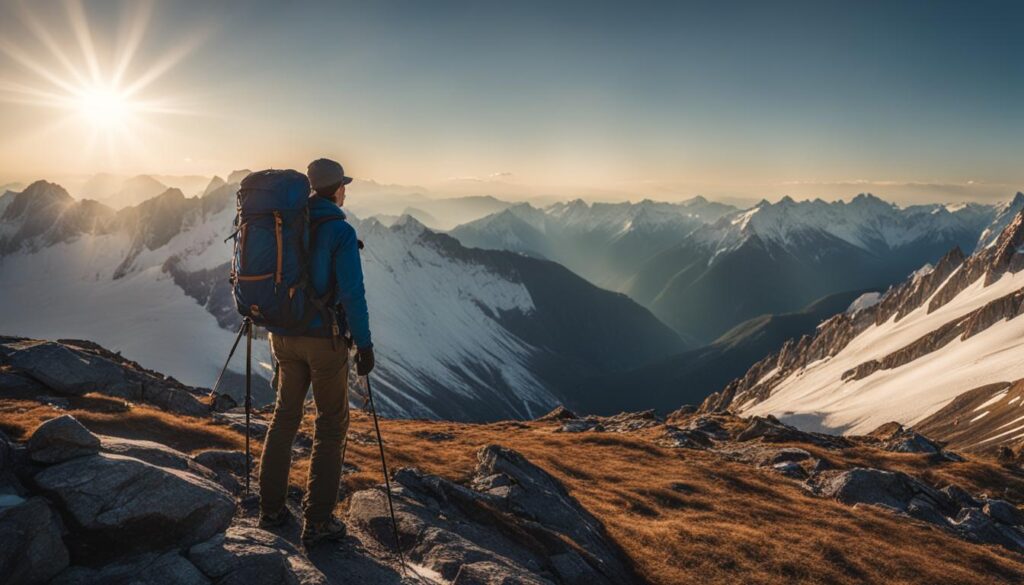
Embarking on your first backpacking trip can be a journey of discovery and accomplishment. But before taking that exhilarating first step onto the trail, you must put in the work behind the scenes. I’m talking about training for backpacking — a ritual that primes your body for the rigorous demands of the backcountry. I can attest that committing to a routine focusing on cardiovascular exercise, strength, and endurance for hiking can make the difference between a grueling slog and an enjoyable trek.
Cardiovascular, Strength, and Endurance: The Triad of Trail Fitness
From my experience, cardiovascular fitness is the engine that powers you through long ascents and the endless miles of backpacking adventures. It’s bolstered through activities like running, cycling, or even brisk walking. I’ve found that incorporating at least three cardio sessions per week helps build a strong foundation for sustained efforts on the trail. Of course, it’s not just about the heart and lungs; strength and endurance for hiking are equally crucial. Integrating strength training into your regimen fortifies your muscles, especially those in your legs, core, and back – the pillars of your hiking form.
And let’s not overlook the virtue of endurance. Pacing up and down hills with a weighted pack simulates the demands of a full day on the trail, and trust me, it pays dividends when the real challenge presents itself. Endurance is not just physical but mental too; those extended training sessions teach your mind to persevere when every muscle fiber is telling you to quit.
“To fully enjoy the serenity of the backcountry, you must prepare your body in the world you know – by pushing it to understand and adapt to the world you’re about to explore.”
Let me break down a basic training for backpacking program:
- At least two cardiovascular workouts per week, like running or cycling, for a healthy heart rate.
- Two days focused on strength training exercises such as squats, lunges, and planks.
- Long walks or hikes during the weekends, preferably on trails with varying elevations.
This multi-faceted approach creates a well-rounded athlete equipped to take on the unpredictability and beauty of the trail.
| Exercise Type | Frequency | Benefits |
|---|---|---|
| Cardiovascular Workouts | 2-3 times per week | Builds lung capacity, strengthens heart, enhances blood circulation |
| Strength Training | 2 times per week | Improves muscle function, supports joints, increases carrying capacity |
| Endurance Hiking | Weekly | Boosts stamina, accustoms body to prolonged activity, mental conditioning |
Commencing this fitness journey at least eight weeks before the trip ensures ample time for your body to adapt and strengthen. And when that anticipated day arrives, when you cinch up your boots and tighten your pack’s waist strap, you’ll stand confident on the trailhead, your body primed for the adventure ahead — all thanks to the dedication you’ve shown in your physical preparation.
Safety and Wilderness Etiquette: Leave No Trace

As I traverse the pristine landscapes that beckon the ever-curious backpacker, I carry with me an ethos that ensures the wilderness remains untouched for those who follow. Wilderness safety for backpackers is not just about personal survival; it’s about stewardship. Acknowledging the majesty of Mother Nature commands a level of respect, akin to a silent oath taken by all who wish to delve into her depths. This respect is embodied in the leave no trace principles—a set of outdoor ethics promoting conservation in the outdoors.
When it comes to backpacking etiquette, these seven principles serve as a compass guiding my interactions with the natural world, ensuring minimal impact on the environment. Let’s unfold these tenets and learn how to incorporate them seamlessly into our wilderness adventures.
“Leave No Trace is more than a set of rules—it’s a state of mind, a way of being that honors the natural world and our place within it.”
Seven Key Leave No Trace Principles
- Plan Ahead and Prepare: By anticipating and preparing for the conditions of the area, we mitigate risk and minimize damage to natural resources.
- Travel and Camp on Durable Surfaces: I stick to established trails and camp in designated areas to prevent soil erosion and protect plant life.
- Dispose of Waste Properly: All waste, be it scraps of food or human waste, is packed out or buried to preserve the ecological balance.
- Leave What You Find: I take only memories, leaving rocks, plants, and archaeological artifacts untouched for others to enjoy.
- Minimize Campfire Impact: Where fires are permitted, I use established fire rings and keep blazes small, or better yet, use a stove for cooking.
- Respect Wildlife: Observing from a distance, I never feed or approach wildlife, allowing them to thrive in their natural habitat.
- Be Considerate of Other Visitors: I preserve the solitude of the wilderness for others by keeping noise levels down and yielding to others on the trail.
It’s these practices that define our commitment to backpacking etiquette and wilderness preservation. But beyond ethics, one must also be equipped with the knowledge and gear essential for a secure trekking experience.
The 10 Essentials: Preparedness for Wilderness Safety
Preparation plays a paramount role in wilderness safety for backpackers. I’ve learned the value of carrying the 10 Essentials—a list of foundational items that can be life-saving in unpredictable backcountry situations.
- Navigation Tools: A map, compass, and GPS guide my journey, ensuring I’m never truly lost.
- Sun Protection: Sunglasses and sunscreen shield me from the unrelenting sun at high altitudes.
- Insulation: Extra clothing prepares me for swift weather changes, especially when the sun dips below the horizon.
- Illumination: A reliable headlamp or flashlight extends my vision into the night, revealing paths and potential hazards.
- First-Aid Supplies: In case of injury, a well-stocked first-aid kit becomes my silent guardian.
- Fire: Waterproof matches, a lighter, or a stove grant me warmth and a means to cook when the cold encroaches.
- Repair Kit and Tools: A multi-tool and repair kits fix unexpected gear mishaps that could otherwise dampen my spirits.
- Nutrition: Additional food fuels my body’s engine, sustaining me if my journey extends beyond expectation.
- Hydration: Adequate water and a means to purify it maintain hydration—the lifeline of any backpacker.
- Emergency Shelter: A tent, bivy sack, or space blanket offers crucial refuge when the wilderness shows its untamed side.
In essence, these tools and principles are my companions, just as vital as the pack on my back. As stewards of the wild, it’s on us to uphold these leave no trace principles, ensuring the beauty and purity of the backcountry for future generations.
| Principle | Why It’s Important | Personal Practice |
|---|---|---|
| Plan Ahead and Prepare | Reduces the risk of emergencies and preserves the environment. | I study maps, weather, and regulations before setting out. |
| Travel and Camp on Durable Surfaces | Prevents damage to undeveloped areas and minimizes the ecological footprint. | I camp at least 200 feet from water sources to protect riparian habitats. |
| Dispose of Waste Properly | Protects wildlife health and keeps water sources pure. | All my trash is packed out, and I use biodegradable soap sparingly. |
| Leave What You Find | Maintains natural aesthetics and preserves history. | I photograph unique finds instead of taking them with me. |
| Minimize Campfire Impact | Prevents wildfires and habitat destruction. | I opt for a portable camp stove that leaves no trace. |
| Respect Wildlife | Ensures the well-being of wildlife populations. | I store food securely and use binoculars to watch animals. |
| Be Considerate of Other Visitors | Helps everyone enjoy a pristine wilderness experience. | I keep group sizes small and avoid loud noises that could disturb others. |
In this shared journey of exploration and preservation, my hope is that each one of us can become an emissary of these principles, ensuring that the places we cherish today will continue to inspire awe in the hearts of those who walk these trails tomorrow.
Wrapping Up: Embarking on Your Backpacking Journey
As I draw this guide to a close, I feel a sense of excitement for you. I recall the anticipation before making the most of my first backpacking adventure, and I’m delighted to pave the way for your own explorations. Beginning backpacking as a hobby is a tremendous step towards a lifetime filled with adventure, discovery, and the irreplaceable satisfaction of overcoming the unknown. From choosing your backpack to selecting the right trail snacks, every aspect culminates in an immersive experience that changes you in subtle yet profound ways.
Even as a beginner, the wealth of knowledge you now possess can turn the daunting into the doable. You’re equipped with the steps to begin backpacking as a hobby and have insight on planning your first backpacking adventure. With each chosen path, may you find the wild’s rhythm that resonates with your spirit, and may each challenge refine your fortitude and appreciation for the vast canvases of nature.
By embracing these insights and guidelines, you stand on the brink of an incredible chapter. So, pack your gear, lace up your boots, and step into the great outdoors with confidence. Here’s to the memories you will create, the personal growth you’ll achieve, and the tales of wilderness wanderlust that await. Happy trails to you, my fellow explorer.
Backpacking for Beginners – Frequently Asked Questions (FAQs)
How many miles should a beginner backpacker hike?
For those just starting out backpacking, a reasonable daily mileage goal is 5-8 miles per day. This allows plenty of time to set up camp, prepare food, rest, and enjoy the scenery along the trail. Pushing yourself too hard as a novice can lead to injury, fatigue, and an unpleasant experience overall. As your fitness level and comfort with carrying a pack improves over multiple short backpacking trips, you can gradually increase your daily trekking distance.
How much money do you need to be a backpacker?
The costs associated with backpacking can vary greatly depending on the gear you choose and the length of your trip. However, you can equip yourself with quality used gear for around $500 to $800. Focus first on essentials like a backpack, shelter, sleeping equipment, and hiking boots or shoes. Then budget additional funds for food, transportation, permits, and activities along the way. Planning affordable trips and sticking to simpler meals helps keep costs down for backpacking beginners.
How do you get started backpacking?
Getting started backpacking requires some research and preparation. First, assemble the 10 essentials like navigation tools, first aid supplies, and appropriate clothing. Then start conditioning your body by taking short hikes with your daypack. Gain wilderness skills and knowledge by taking a class or going on a backpacking trip with experienced friends. Dial in your gear by car camping close to home before embarking on an overnight backpacking adventure in the backcountry.
How long should a beginner’s backpacking trip be?
For your first few times backpacking, limit your trip length to 2-4 days. This provides enough time to get the feel of carrying a loaded pack over varied terrain without overexerting yourself. As you condition your body and refine your gear and camping skills, you can gradually ramp up to longer 5-7 day backcountry excursions. Remember there is no set time frame for taking on longer trips – progress at your own pace based on your comfort and abilities.
Where do you sleep when backpacking?
Backpackers rely on tents or tarps for overnight shelter on the trail. Look for designated backcountry campsites or wilderness zones that allow dispersed camping when planning your route. Be prepared to camp on durable surfaces at least 200 feet from water sources, trails, and other delicate ecosystems. Note that some popular parks and trails require reservations or permits for backcountry camping due to the high volume of visitors.
